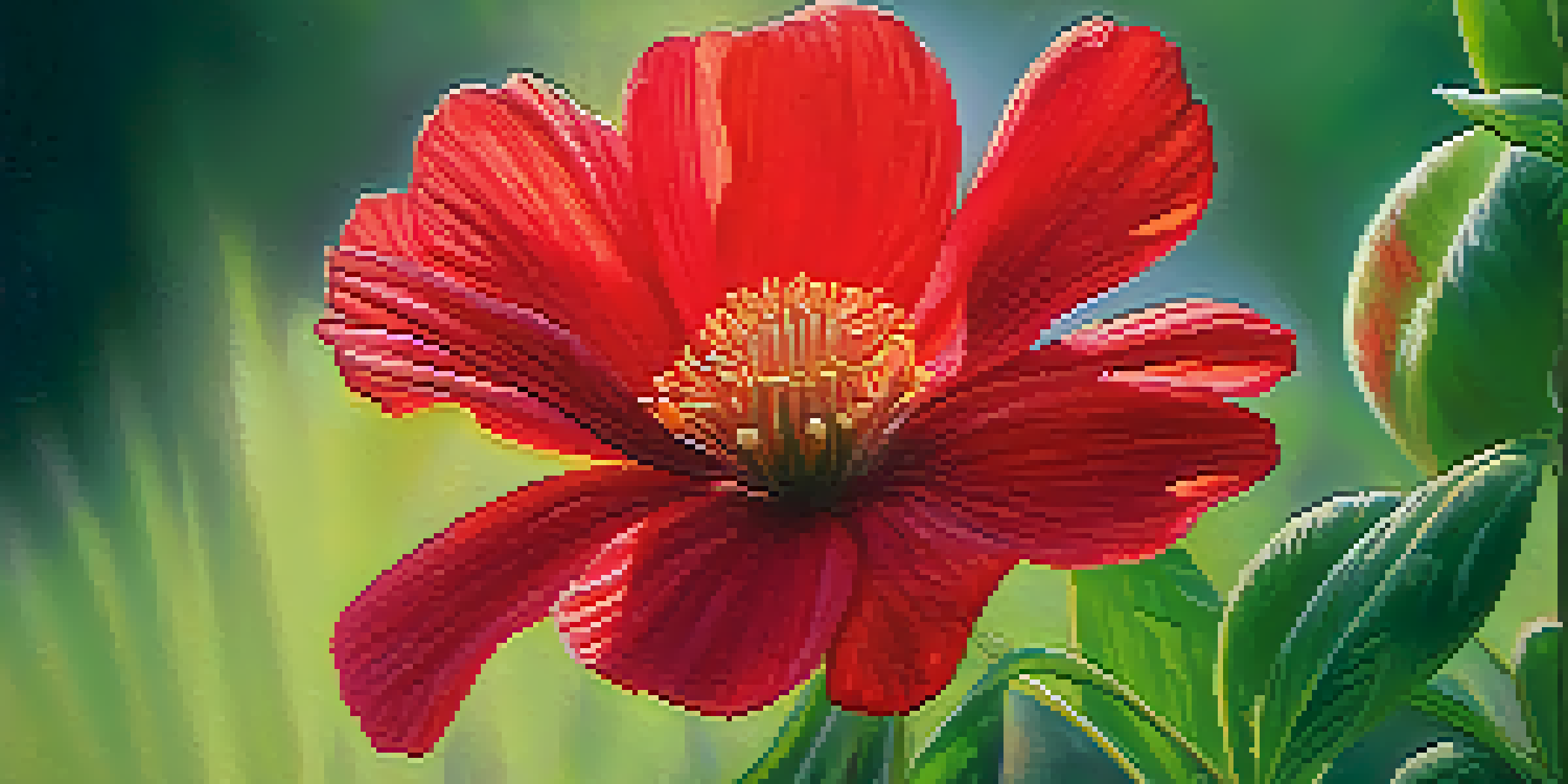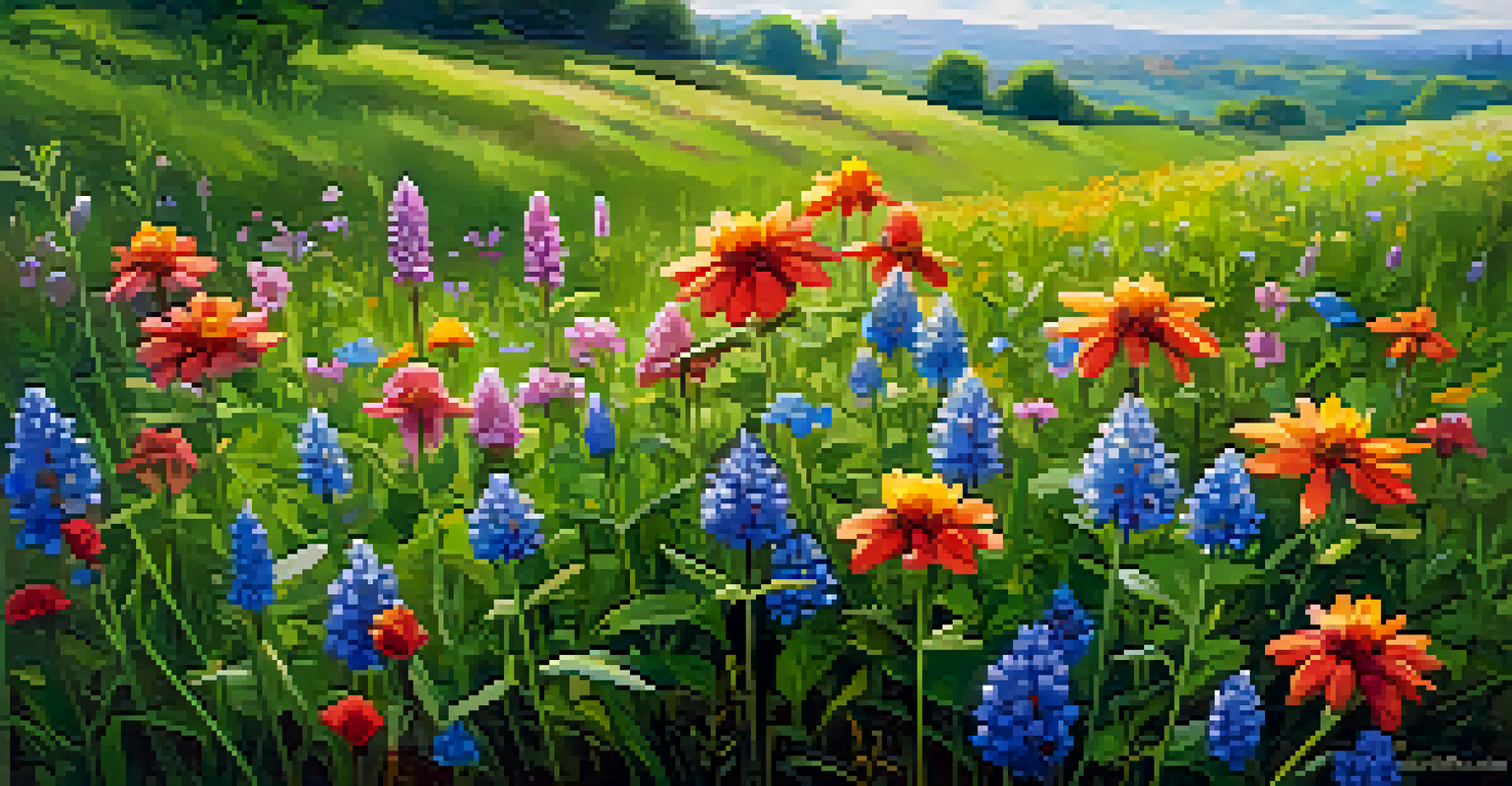The Importance of Backgrounds in Plant Photography

Why Backgrounds Matter in Plant Photography
Backgrounds play a crucial role in plant photography, setting the stage for your subject. A well-chosen background can enhance the beauty of the plant, while a distracting one can take away from its appeal. Just like in a theatrical performance, where the backdrop can change the entire mood, backgrounds in photography help convey the story you want to tell.
A good photograph is knowing where to stand.
When photographing plants, a clean and complementary background allows the colors and textures of your subject to shine. Think of it like framing a painting; the right frame highlights the artwork, while a poor choice can overshadow it. This principle applies to photography as well, where simplicity often leads to stunning results.
Additionally, backgrounds can provide context, giving viewers insights into the plant's natural habitat. For instance, a vibrant green leaf against a textured bark can evoke a sense of the forest. By carefully considering your background, you can create a narrative that speaks to the viewer, making your photographs more engaging.
Types of Backgrounds and Their Effects
There are several types of backgrounds to consider when capturing plant photography. Solid colors, natural settings, and textured surfaces each bring a different feel to the image. For example, a bright blue sky can convey a sense of openness, while a rocky surface can add a rugged charm that complements certain plants.

In addition, the use of blurred backgrounds, often achieved through a technique called bokeh, can help your plant stand out sharply. This soft-focus effect creates a dreamy atmosphere and directs the viewer's attention to your subject. It's like putting a spotlight on your plant, ensuring it gets the admiration it deserves.
Backgrounds Enhance Plant Photos
Choosing the right background can significantly enhance the beauty and narrative of your plant photography.
Conversely, cluttered or overly busy backgrounds can detract from the subject, making it hard for viewers to appreciate the plant's beauty. It’s important to strike a balance between the background and the plant to ensure that both elements work harmoniously together.
Tips for Choosing the Right Background
Selecting the right background can feel overwhelming, but it doesn't have to be. Start by considering the colors and shapes in your subject. For instance, if you’re photographing a vibrant red flower, a muted green background can provide a stunning contrast. This technique draws the eye and allows the flower to pop.
You don't take a photograph, you make it.
Lighting also plays a significant role in background selection. Natural light can create different moods depending on the time of day. Early morning or late afternoon light, often referred to as the golden hour, can enhance the colors and textures of both the plant and its background, creating a magical effect.
Lastly, don't hesitate to experiment! Sometimes, the most unexpected backgrounds can lead to breathtaking results. Try different angles, distances, and environments until you find the combination that feels just right.
Natural vs. Artificial Backgrounds
When it comes to backgrounds, you can choose between natural settings and artificial ones. Natural backgrounds, like gardens or parks, often provide rich textures and colors that enhance the beauty of your plant. These settings can evoke a sense of authenticity and connection to nature, making your images feel more relatable.
On the flip side, artificial backgrounds, like a solid-colored backdrop or a studio setup, offer a clean and controlled environment. This allows for greater focus on the plant without distractions from the surroundings. Think of it as a blank canvas where your subject can take center stage without any competition.
Experiment with Background Types
Different backgrounds, whether natural or artificial, can create various moods and effects in your images.
Both options have their merits, and the choice ultimately depends on the mood you wish to convey. Whether you opt for the organic feel of nature or the sleek simplicity of a studio, each background can tell a different story.
Editing Backgrounds for Better Impact
Editing can be a powerful tool in plant photography, especially when it comes to backgrounds. Software like Adobe Lightroom or Photoshop allows you to adjust the background's brightness, contrast, and saturation, enhancing your overall image. For instance, you can slightly blur a busy background to draw more attention to your plant.
Moreover, you can completely change or remove backgrounds if needed. This technique can be particularly useful when working with indoor plants or in less-than-ideal outdoor settings. By isolating your plant and placing it against a more appealing background, you can create a polished and professional look.
However, it's important to edit responsibly. While enhancing a background can improve your image, over-editing can lead to an unnatural appearance. Aim for a balance that maintains the plant's integrity while elevating the overall aesthetic.
Incorporating Backgrounds into Your Composition
Composition is key in photography, and backgrounds play an essential role in that. Using techniques like the rule of thirds can help you position your plant in relation to its background effectively. By placing the plant off-center, you can create a more dynamic and interesting image that encourages viewers to explore the entire scene.
Leading lines, another compositional technique, can guide the viewer's eye from the background to the plant. Paths, branches, or even lines of light can create a visual journey that connects the background with your subject. This creates a cohesive image that feels intentional and well-thought-out.
Editing Backgrounds for Impact
Editing tools can help improve backgrounds, but it’s essential to maintain a natural appearance for your plant.
Ultimately, the way you incorporate backgrounds into your composition can elevate your photography from good to great. It's all about creating a harmonious relationship between your plant and its environment.
Final Thoughts on Backgrounds in Plant Photography
In conclusion, backgrounds are not just an afterthought in plant photography; they are a vital component that can significantly impact your images. By carefully selecting and considering backgrounds, you can enhance the beauty and story of your plants. This thoughtful approach allows you to create captivating photographs that resonate with viewers.
Remember, every plant has its own personality, and the background should reflect and amplify that character. Whether it’s a lush garden or a simple studio backdrop, each choice contributes to the overall narrative of your photograph. Don't shy away from experimenting until you find what works best for you.

Ultimately, the art of plant photography is about exploration and creativity. By understanding the importance of backgrounds, you can unlock new potential in your work and create images that truly stand out.